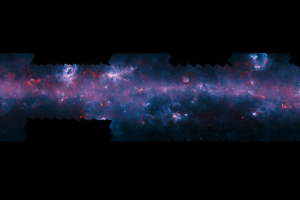A spectacular, new view of the Milky Way was released by scientists Wednesday (Feb. 24), after an APEX (Atacama Pathfinder EXperiment) telescope in Chile mapped the full area of the Galactic Plane visible from the southern hemisphere for the first time at submillimeter wavelengths, which is between infrared light and radio waves. Images show the distribution of the cold dense gas along the plane of the Milky Way.
The project was part of the APEX Telescope Large Area Survey of the Galaxy (ATLASGAL). This pioneering APEX telescope allows astronomers to study the cold Universe: gas and dust only a few tens of degrees above absolute zero, reports the European Southern Observatory. ESO is intergovernmental astronomy organization in Europe that is supported by 16 countries: Austria, Belgium, Brazil, the Czech Republic, Denmark, France, Finland, Germany, Italy, the Netherlands, Poland, Portugal, Spain, Sweden, Switzerland and the United Kingdom, along with the host state of Chile.
ESO experts indicated the new images include most of the regions of star formation in the southern Milky Way.
The ATLASGAL survey is the single most successful APEX large program with nearly 70 associated science papers already published, and its legacy will expand much further with all the reduced data products now available to the full astronomical community.
"ATLASGAL provides exciting insights into where the next generation of high-mass stars and clusters form. By combining these with observations from Planck, we can now obtain a link to the large-scale structures of giant molecular clouds," said Timea Csengeri from the Max Planck Institute for Radio Astronomy (MPIfR), Bonn, Germany, who led the work of combining the APEX and Planck data.
Ten years of successful research by the APEX telescope recently was celebrated, especially as it provides new data for the cold universe.
Leonardo Testi from ESO, who is a member of the ATLASGAL team and the European Project Scientist for the ALMA project, concludes: "ATLASGAL has allowed us to have a new and transformational look at the dense interstellar medium of our own galaxy, the Milky Way. The new release of the full survey opens up the possibility to mine this marvelous dataset for new discoveries. Many teams of scientists are already using the ATLASGAL data to plan for detailed ALMA follow-up."
Submillimeter astronomy, and the study of the cold universe, allows astronomers to use light to study the chemical and physical conditions of cold clouds in interstellar space, where stars are born, reports International Business Times.
"Seen in visible light, these regions of the Universe are often dark and obscured due to the dust, but they shine brightly in the millimeter and submillimeter part of the spectrum," ESO said in a statement. "This wavelength range is also ideal for studying some of the earliest and most distant galaxies in the Universe, whose light has been red-shifted into these longer wavelengths."

















